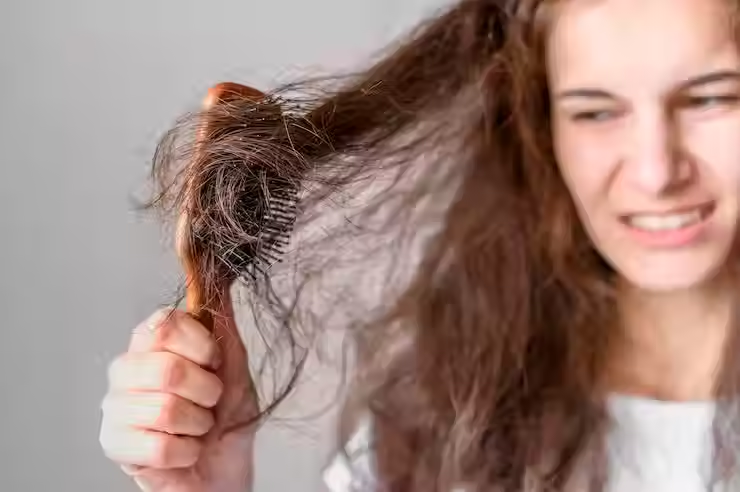Understanding Hair Porosity + Common Scalp Conditions: What You Need to Know
- Peach & Umber
- 5 days ago
- 3 min read
Updated: 24 hours ago
Healthy hair starts with understanding your hair's needs — and one of the most important factors is hair porosity. Hair porosity refers to how well your hair absorbs and retains moisture. Knowing your porosity can completely change how you care for your natural hair. Let's dive into the three types: low, high, and normal porosity — and then, we’ll talk about important scalp conditions every naturalista should know about.

What is Hair Porosity?
Hair porosity is determined by how tightly or loosely the cuticles (the outer layer of the hair) lay along the hair shaft. Think of cuticles like shingles on a roof: when they’re tight, less water gets in; when they’re loose, too much water can rush in and out.
Low Porosity Hair :
What it means: Your hair’s cuticles are tightly closed, making it difficult for water and products to penetrate. Instead of absorbing moisture, products often sit on top of your hair.

Common struggles:
Hair feels product-heavy or greasy.
Water tends to bead up on the surface instead of soaking in.
Care tips:
Use steam treatments to gently lift the cuticle and allow moisture in.
Opt for lightweight, water-based products and avoid heavy butters or oils that can build up.
Apply products to damp, warm hair to encourage better absorption.
High Porosity Hair:
What it means: Your cuticles are raised or even damaged, which means your hair absorbs moisture quickly but loses it just as fast. This can happen naturally or be the result of heat or chemical damage

Common struggles:
Hair dries out very quickly after washing.
Frizz and tangling are frequent issues.
Care tips:
Deep condition regularly with thicker conditioners or hair masks rich in proteins and oils.
Use leave-in conditioners and heavier sealants like creams and butters to lock in moisture.
Avoid high heat styling and harsh chemicals to prevent further damage.
Normal Porosity Hair:
What it means: Your cuticles are slightly raised, allowing moisture to enter and stay put without too much trouble. This is the "ideal" porosity because your hair naturally balances moisture retention and product absorption.

Common struggles:
Care tips:
Maintain regular deep conditioning treatments to keep hair strong and hydrated.
Use a balanced routine: not too heavy, not too light.
Protect hair with satin or silk bonnets and pillowcases at night to avoid unnecessary friction and dryness.
Understanding Scalp Conditions: Dandruff vs. Dermatitis vs. Dry Scalp vs. Psoriasis
A healthy scalp is just as important as healthy hair. But not every flake or itch means the same thing. Here's the breakdown:
Dandruff:
What it is: Dandruff is caused by an overgrowth of yeast (Malassezia) on the scalp, leading to oily, large, yellow or white flakes

Signs:
Flaking is greasy and clumps together.
Itching and irritation are common.
Solutions:
Dermatitis (Seborrheic Dermatitis):
What it is: A more severe form of dandruff, seborrheic dermatitis causes inflamed, red, scaly patches on the scalp and sometimes other oily areas like eyebrows and ears.

Solutions:
Medicated shampoos containing ketoconazole, selenium sulfide, or zinc pyrithione.
Consult a dermatologist for proper diagnosis and care
Dry Scalp:
What it is: Dry scalp happens when your scalp doesn’t produce enough natural oils (sebum), often triggered by cold weather, dehydration, or harsh hair products.

Signs:
Small, dry, white flakes that fall off easily.
Tightness or itchiness without redness.
Solutions:
Hydrate your body and scalp.
Use gentle, moisturizing shampoos and oils like jojoba or tea tree oil.
Psoriasis:
What it is: Psoriasis is an autoimmune condition that causes thick, scaly plaques to develop on the skin, including the scalp.

Signs:
Silvery-white scales over red, inflamed patches.
Itching or soreness.
Solutions:
Final Thoughts:
Understanding your hair porosity and recognizing common scalp conditions can completely change how you care for your hair. Tailoring your routine to your hair’s needs and treating scalp issues early will lead to healthier, stronger, more beautiful hair.
🌿 Always consult with a trichologist or dermatologist if you’re unsure about your scalp health



Comments